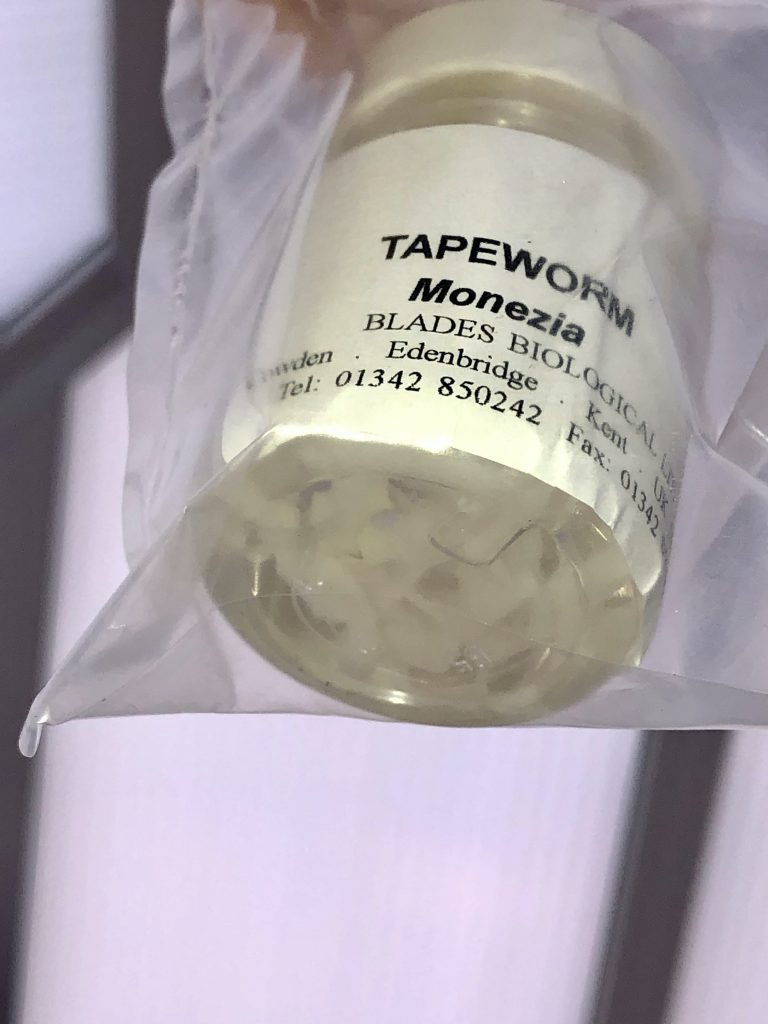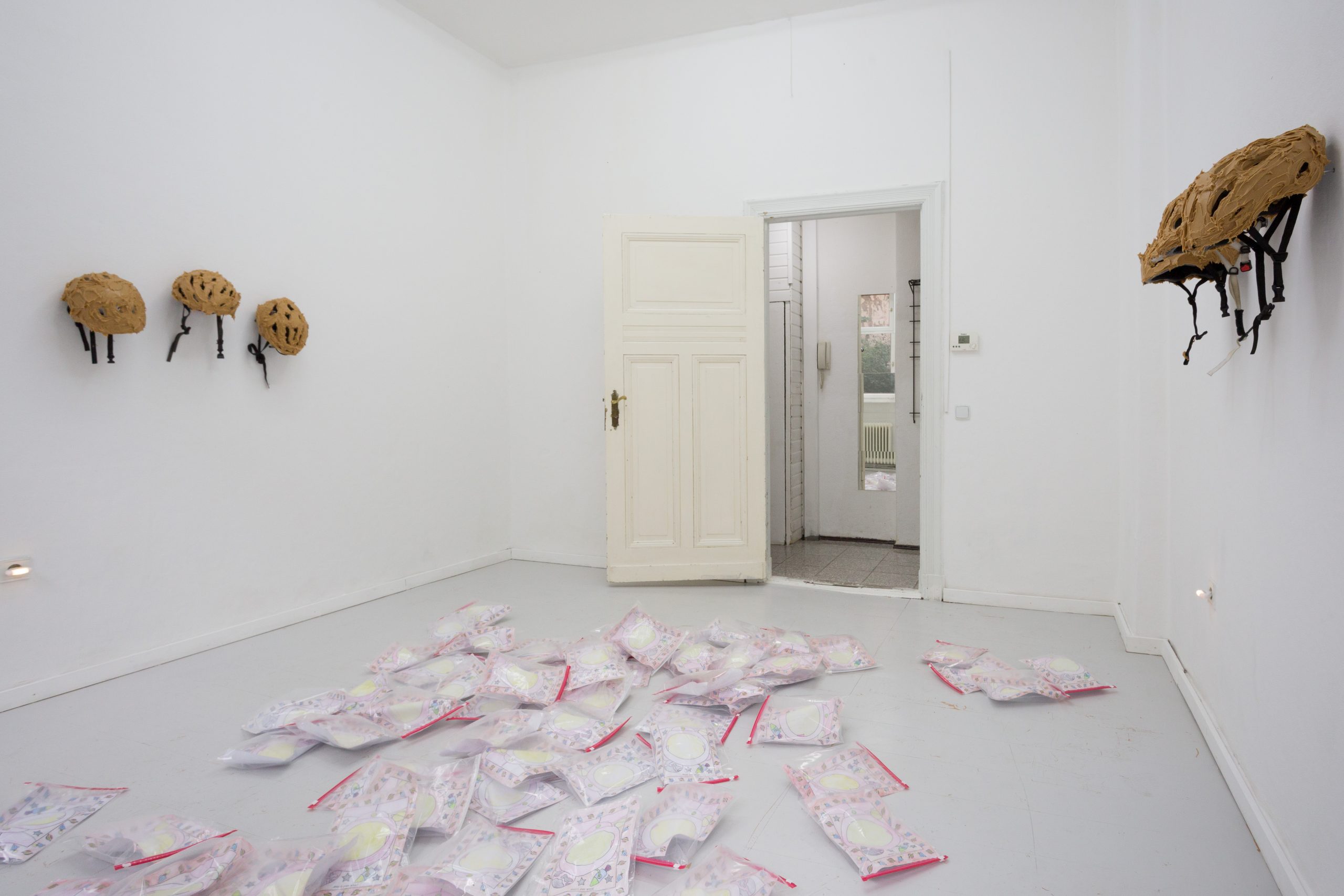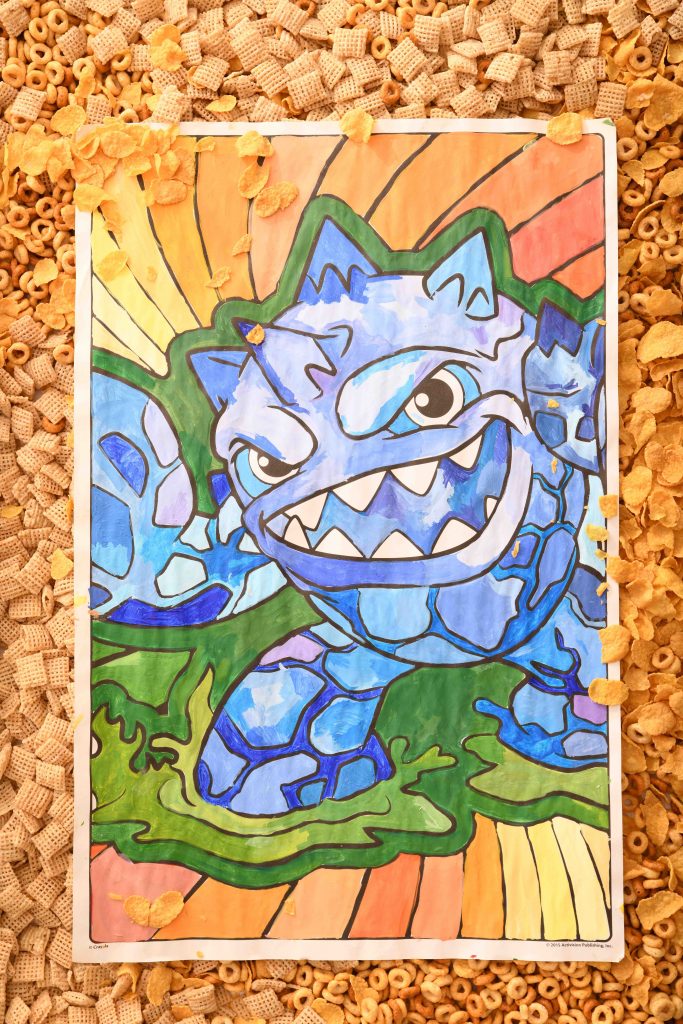Sophie Serber sends me an email with the subject-heading, ‘Lucid writing’. It contains a ten-page, 3,500-word document that’s colour-coded in an attempt to communicate her thoughts around her solo exhibition at Vienna’s Shore Gallery, curated by me. Opening as part of the Austrian city’s Curated by gallery festival on September 5 and running to October 24, Bracket Sentiment And The Technicolor Yawn is less a contemplation of and more a reaction to notions of dependence, body memory and trauma.

The thinking behind the titling isn’t entirely clear but its reference to the Bible-inspired musical comedy, Joseph and the Amazing Technicolor Dreamcoat, among other things, mirrors the naivety of a series of kid’s coloring-book pages, messily painted and embedded in cereal, then hung on the gallery walls. There’s a sound recording of Serber reciting garbled words while running on a treadmill, but her squeaking sneakers sound like sex. That, paired with the Digimon cartoon visuals and ambivalent smell of Shreddies mixed with Cheetos feels creepy, perverse. “You decide, or you’re told, or you inherit where that line is and whatever you kind of see or understand is your reality,” says Serber via video chat from her base in London about these intuitive gestures to universal forms of children’s activities. “It’s stuffed, it’s colored in, right? Those lines prevent it from getting muddy. They separate.”
Trying to get Serber to explain her work directly can be frustrating. The American artist has trouble ordering her thoughts and feelings, and communication in the conventional sense is difficult. There’s a violence in language’s drive to label and categorize that Serber’s work actively undermines in its refusal to be read. At the back room of Shore, lies a dimly-lit model of tapeworm—a to-scale silicon sculpture of a parasite that can only live in relation to its host. When removed or made visible, it dies. One gets the sense that Serber identifies with the tapeworm, as a person who suffers from an unrecognized chronic illness called multiple chemical sensitivity. It’s the one where a person displays vague symptoms to common agents. They’re allergic to life. They’re sensitive to expectation.

“I prepared so thoroughly in writing complete sentences that went with each other,” says Serber, exhausted from a sleepless night, anxious over having to explain her complicated thoughts in an interview context. She keeps one eye on the color-coded document on her screen, marked with titles like ‘disgust’, ‘dependency’ and ‘visibility of container’ and partially paraphrasing Wikipedia entries. Serber clarifies, “I’m trying to not look at my notes.”
**It’s funny, you’re doing an interview with me to be interpreted but you’re also wanting to control that interpretation, while refusing to be interpretable.
Sophie Serber: Yeah. I think once you’re seen you’re dead, but then if you’re not seen then you can’t connect, or merge with other people.
**So, being seen, or being able to communicate is a social adaptive behavior?
SS: What do you mean?
**Well, you’re saying you don’t want to be visible, but then being visible is a way of connecting to other people. So that implies that connecting with other people is important. Therefore, you’re adapting your behavior in order to connect.
SS: Yeah. I guess I want to be able to be useful in a certain way, or like I’m very dependent. So, I think in order to give back in some way, I need to be understood or need to be visible because people are really satisfied by that.
**So then how do you achieve visibility?
SS: Well, I guess in the sound work, I try and do that. There are options. In some ways people have to be okay with ‘placeless-ness’ or being okay with not having a place to put you. So sometimes I think about communicating with options to communicate without language, or without words, something pre-linguistic. Affect—is affect enough?

**Can you tell me something about how you started your art practice?
SS: When I was in middle school I was really into the Enneagram, which is a personality test. I was giving it to people and then drawing what I saw. I started doodling repetitive patterns to disassociate in some way. I actually don’t even remember what it is. Before I would be able to tell you exactly all about it, but I can’t now.
**So, you would give people a personality test and then based on their personality type, you would do a drawing. Were you any good at it, is that what made you want to carry on?
SS: No, I was not patient enough to be good at drawing. I was very impulsive and erratic. I guess I liked to just like use my hands. There was a time that I was very patient and that I was very sharp and I was good at drawing and I’m capable of that, but it fluctuates. When I was in university, I was pretty good at drawing symbolic things, or people, but in high school I was just doing patterns. I was good at making patterns but, yeah, I don’t have much talent.
**So then there’s this ongoing relationship between psychology—or quack psychology—and art.
SS: Yeah, for sure.
**You initially went to Pratt Institute, did you finish?
SS: No, I transferred. I actually became super allergic and I had to leave New York. I had this thing called… it’s like an invisible thing.
**Environmental illness?
SS: Yeah, multiple chemical sensitivity. It’s also called idiopathic environmental intolerance. There are physical risk factors and some people say they’re allergic to electromagnetic fields.

**It’s still debated whether it’s a real thing, right?
SS: Yeah. The symptoms are vague and they’re not very specific, but they do elicit biological responses at the same time, so I guess that’s where some of my interest in visibility and dependence comes from because I can’t be so independent. There’s also ‘interdependence’ but I think I’m just dependent. That means I cannot give back in the traditional modes of contributing. I want to think about what’s offered through dependency, like service, or if people can validate that something that is unseen and useless has any place.
I’ve been trying to talk about how I’m dependent on strangers, or those around me, to not use the materials that I’m allergic to because I’ll get sick. It makes me distance myself from people and see things in people that are frustrating because they don’t really believe it’s real, or they don’t respect it because they can’t see it on me. It frustrates me that because it’s not visible, it doesn’t have any gravity or weight.
**When did the illness and allergies start?
SS: It started when I melted a lot of aluminum and I was living somewhere with black mold. They say that one of the elicitors, or a lot of people get it right when they’re exposed to a ton of toxins and then they just become super sensitive. But I think in Australia, they recognize it as a grounded, relevant illness.
**That kind of makes sense, would it be regarded as an autoimmune disease, do you think? Diseases that are more prevalent in women that no one knows anything about.
SS: Yeah, it is. The movie Safe is about it. It’s also a metaphor for AIDS but I think people don’t really see that that thing that they’re talking about is also real. That movie was made in 1995 and things haven’t changed.

**Can you explain a little bit of that movie for me?
SS: I’m really bad at relaying narrative, especially on no sleep, but Julianne Moore kind of falls apart—she gets bloody noses and becomes really sensitive. She goes away to a place where you heal, and there’s a bunch of other people who are similar and struggling with similar things, but actually those things exist. There’s a place called Snowflake where people go and it’s very, very regulated. People live in aluminum structures and a woman smells you before you can become part of it to make sure that you don’t have anything on you. You have to tie up your hair.
**Have you been to this place?
SS: No, no, no. It’s in the desert somewhere. I haven’t been sick enough for that.
**I’ve been thinking a lot about immunity as a concept, especially now—which is also why a lot of people have been watching Safe—because the very mechanism that we assume is supposed to protect you can also kill you.
SS: Exactly. There’s also this thing called the behavioral immune system, which I think is really interesting right now because it also protects you from intimacy. It’s like a psychological mechanism that makes you engage in behaviors that prevent contact with potential disease-causing parasites. They’re sensory processes that trigger a bunch of cognitive and behavioral reactions, so once you’re disgusted, it is pretty much impossible to change that, or it’s very, very difficult. It automatically activates behavioral avoidance and they’ve done a lot of research that this disease avoidance process contributes to prejudices. You think that with an object or something else’s essence, once you touch it, it becomes part of you.
**This idea of not being able to return from disgust, it’s like if you’re eating something and there’s an unexpected texure of some sort, and then you’re irrevocably revolted by the thing you were just eating.

SS: But then it’s already inside you and that makes it even grosser.
**What is your relationship to disgust, in your work especially?
SS: I guess it gives people a place, in some way. We get disgusted by things that aren’t absorbable or observable. So I guess it also relates to sex because, in the behavioral immune system, we are often repulsed by sex, or you’re kind of disgusted, and that’s where disgust is protecting you from intimacy.
**But why do we need to be protected from intimacy, isn’t that what we desire? Obviously, we’re all experiencing it in a collective way right now, where we all desire intimacy, but it is bad for us. But in relation to what you said about behavioral immunity, why would it prevent you from what is presumably and perceivably a biological or reproductive objective of sex.
SS: There’s the biological and then there’s also disgust that you inherit from culture.
**Like homosexual activity.
SS: Yeah. Or like the idea of the slut.
**Where do you think this inherited disgust comes from? Is it because the idea of the slut is more prone to disease, or because gay sex is not reproductive? Why is that form of disgust culturally embedded?
SS: Disgust is this pre-linguistic thing. When you’re disgusted, your body employs the same thing as digestion. Your stomach growls, your temperature goes down, and so does your pulse. It’s the only emotion that makes your pulse go slow. It’s like a very specific thing but your belief system determines what you’re disgusted by.
**Could this pre-linguistic physiological response then be connected somehow to certain traumas?
SS: Well, your body has memory. Trauma is not something other people can see but it’s inside you. So, yeah, of course, everything’s connected.**













